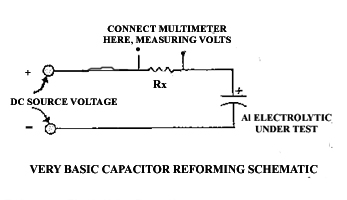HOW TO CARE FOR YOUR ALUMINIUM ELECTROLYTIC CAPACITORS (AND YOURSELF!)
REFORMING ALUMINIUM ELECTROLYTIC CAPACITORS
Within an aluminum electrolytic capacitor there is a large area of aluminum foil and an electrolytic paste. As the voltage is applied to the capacitor, current flows until aluminum oxide forms on the surface of the foil, because aluminum oxide is a very good insulator this is a critical process to the usefulness of a capacitor.
REFORMING is the process of ensuring that this aluminium oxide is present, if the coating is not present then the capacitor will pass DC current, not function correctly and is quite likely to heat up internally - this is definitely not a good thing!
The process of reforming an old aluminum electrolytic capacitor consists of the application of the capacitor rated voltage, through a resistor, for a period of time, usually around one hour for each year of storage or estimated time the capacitor has been stored.
ALL of the aluminium electrolytic capacitors I am offering are either unused/new old stock or used and should be reformed prior to use.
I have NOT undertaken any reforming of these capacitors, I saw little point as I don't know how long they make take to find new homes (if at all)
Keep in mind that ALL (including "brand new") Aluminium electrolytic capacitors have a "shelf life" or "idle non-operating life" which means that if the capacitor is not "fresh" (manufactured within 6 ~ 12 months) reforming MAY be required. If your stock or even new purchases of Al electro's don't seem to be doing their job properly, it could be worthwhile to put them through the reforming process as a precaution.
Actually ALL older electronic equipment, which usually contain aluminium electrolytic capacitors, should always be "bought up to full AC input voltage" slowly using a Variac. Old timers know this only too well, they will ALWAYS power up an old piece of valve based equipment via a Variac and SLOWLY increase the AC input voltage to that equipment - this at least gives the capacitors time to reform a little before having full DC voltage applied to them.
I have seen a lot of old (and some not so old) gear suddenly make LOUD banging noises, puff of smoke etc because full AC input was applied and the electrolytic capacitors suddenly were passing very high currents (not formed) which then causes considerable heat inside the capacitor and sometimes this results in the capacitor self destructing!
Even "not so old" equipment can do this - I had a NAD amplifier from the 1980's and it had not been used for around 5 years. I powered it up NOT via a Variac (I forgot! the mind does this when you get older) and almost immediately one of the electrolytic capacitors (power supply filter capacitor) committed suicide! If I had been more cautious, a slow reforming (winding up of the AC input voltage) would most likely have prevented this happening.
HOW DO I REFORM MY ALUMINIUM ELECTROLYTIC CAPACITORS?
The circuit below is crude and imprecise but it will "do the job" reforming an aluminium electrolytic capacitor. The resistor value is not critical and any value between approximately 22K ~ 56K Ohm will do fine, with a power rating of anything above 5 Watts. This resistor's purpose is to limit current flow when the capacitor under test is connected and it also provides a point at which the circuit current flow (voltage drop across the resistor) can be measured. The precise amount of current flowing is not critical but it is important that after initial connection of the capacitor a voltage drop change (becoming less) is seen over time, keeping in mind that by the very nature of the capacitor, it should be extremely low or zero as the nature of a capacitor is to impede DC current flow - higher than expected currents indicate the capacitor is in need of reforming (or it has an internal fault) As an indication, as the capacitor reforms, the voltage across the resistor will drop (measured at the points indicated in the schematic below). If that voltage will not drop below 10% of applied voltage after one hour, this is not a good sign (for the capacitor's useability)
Typically the meter is your multimeter (nothing special is required) and the voltage source should be variable so that you can reform a number of different capacitors with different working voltages.
In the past I have used a simple transformer/bridge/filter capacitor giving a DC output in the region of 500V (highest capacitor working voltage I was likely to test) and I used a variac to alter the AC input to the transformer DOWN from our standard 240V domestic supply i.e if I wanted a test DC source of 60V, I would wind down the AC input to the transformer to around 28V AC input (approximately). Pretty rough and ready but it worked.

NOTES:
Check and double check the DC voltage output of your source supply is correct for the capacitor under test/reformation
As always, ensure the test source supply polarity is correctly connected to the capacitor to be reformed!
PERSONAL SAFETY:
A good capacitor will store its energy for quite a while, that is desirable BUT the capacitor can discharge through the hand of the technician when picked up! The shock received can certainly be startling or even life threatening if it causes the hand to move against other dangerous parts of circuit or if a pre-existing health condition exists - DON'T RISK IT!
While this is not a big issue for lower voltage electrolytics, anything above 80 Volts should be treated with the greatest respect AND discharged by placing a resistor (100 ~ 470 Ohm are reasonable choices up to 500 Volts working) across the two capacitor terminals prior to handling, discharging the capacitor in a controlled manner.
As a "precaution" I tend to store and provide all electrolytic capacitors above 80V with Aluminium foil across the terminals/leads, preventing any charge build up - remove this before use of course!

